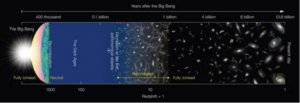
Line intensity mapping (LIM) surveys can be used to understand the properties of galaxy evolution on a cosmic scale. By detecting the aggregate emission from every galaxy emitting in a given line, LIM surveys provide a nearly complete census of galaxies in a given region. Different lines can be used to infer different properties of the galaxy population, tracing, e.g. the abundance of star-forming gas, or tracers of the cumulative star formation emission. LIM surveys can provide decisive explanations of cosmic mysteries of galaxy evolution including the epoch of reionization and the ‘Cosmic Noon’, the mysterious peak in cosmic star formation that occurred around around redshift two, about 10 billion years ago.
Detection of neutral hydrogen (HI) enables a direct measurement of galaxies by tracing the abundance and ionization of hydrogen gas in galaxies. Ionized carbon (CII) and carbon monoxide (CO) also trace star formation, tracing the cumulative star formation activity and the abundance of cold, star-forming gas. Our group specializes in instrumentation in both of these regimes, with current involvement in the Tianlai and proposed PUMA telescopes aimed toward HI, and EXCLAIM focusing on CO and CII.
The Timbie Group also has expertise in sub-millimeter detectors, crucial to CO and CII detection. The new era of highly sensitive and highly scalable detectors at mm-FIR frequencies on airborne, balloon-borne, and (in the future) space-borne instruments enables a revolutionary understanding of galaxy evolution. Kinetic Inductance Detectors (KIDs) are a key enabling technology for mm-FIR astronomy, owing to the detectors’ scalability, sensitivity, and tunability. EXCLAIM is among the first experiments to be equipped with KIDs, which enable groundbreaking measurements in mm-FIR astronomy, while also forming powerful proof of concept and guide for their potential use in future missions, including potential future space missions.
